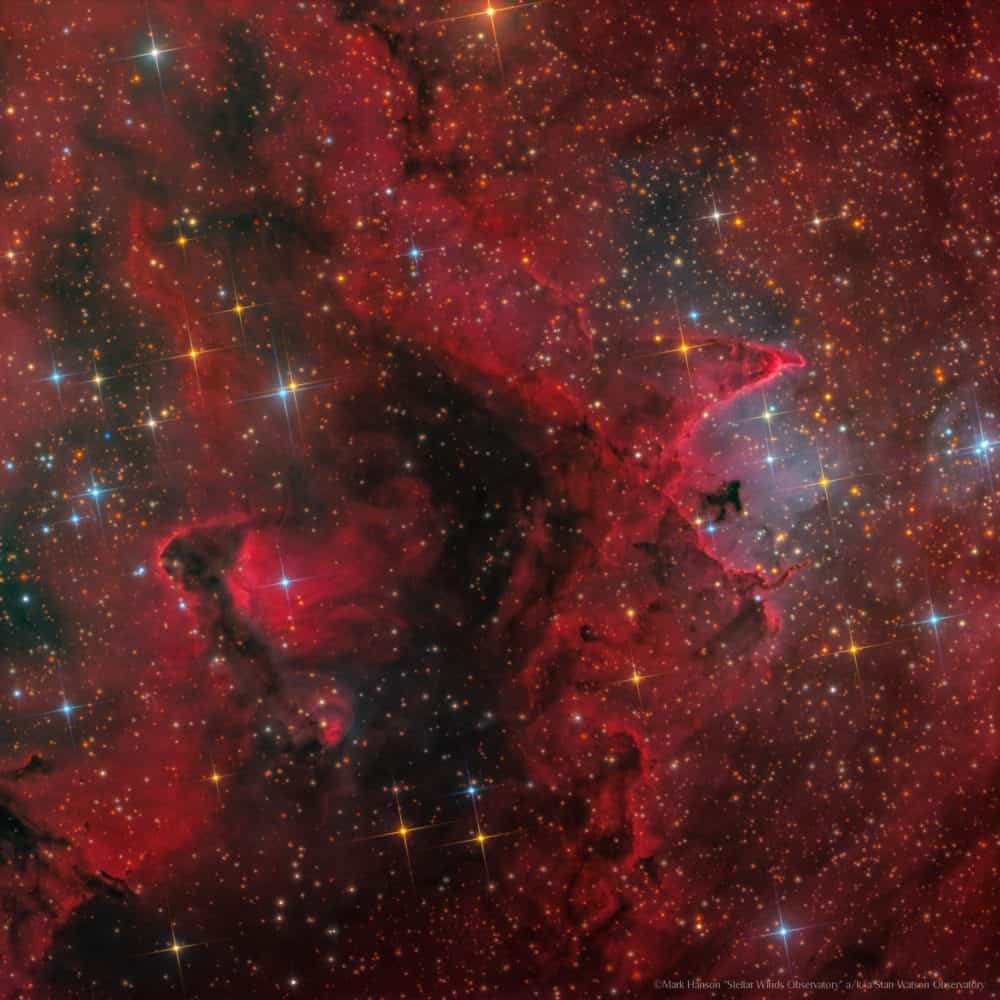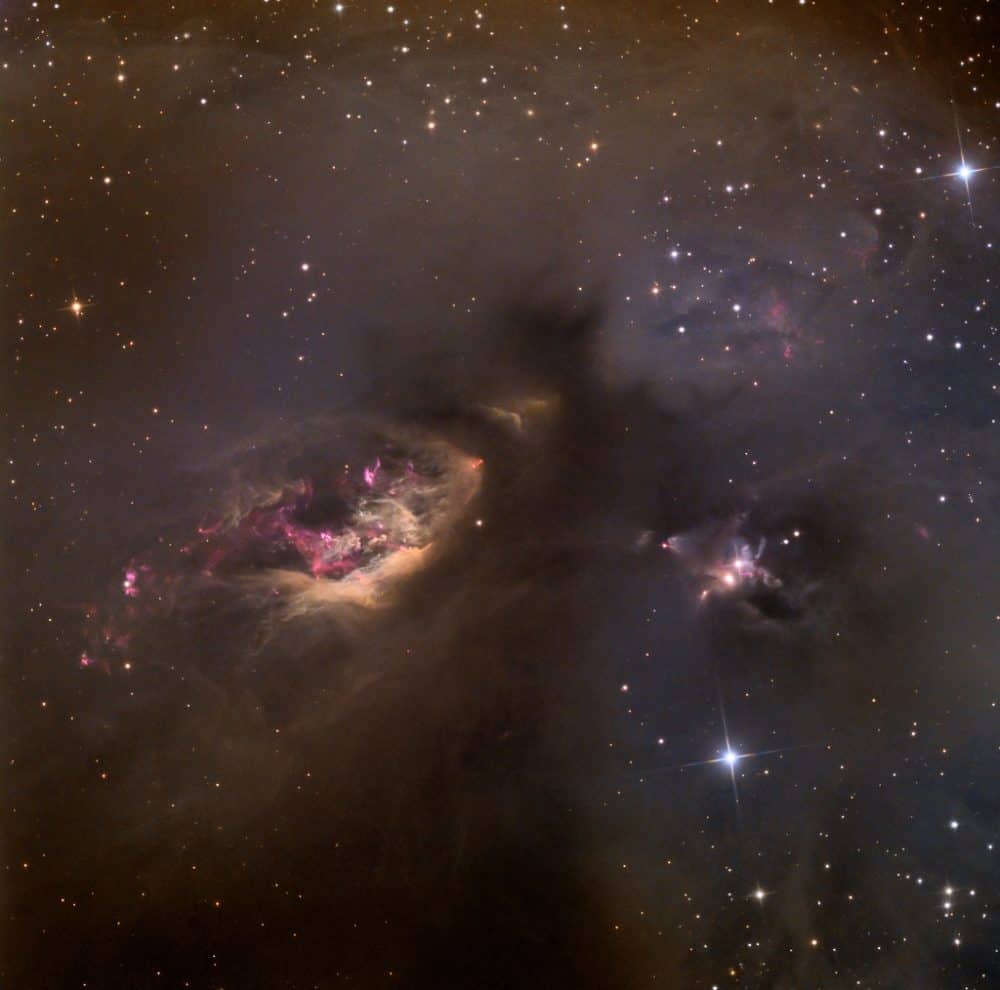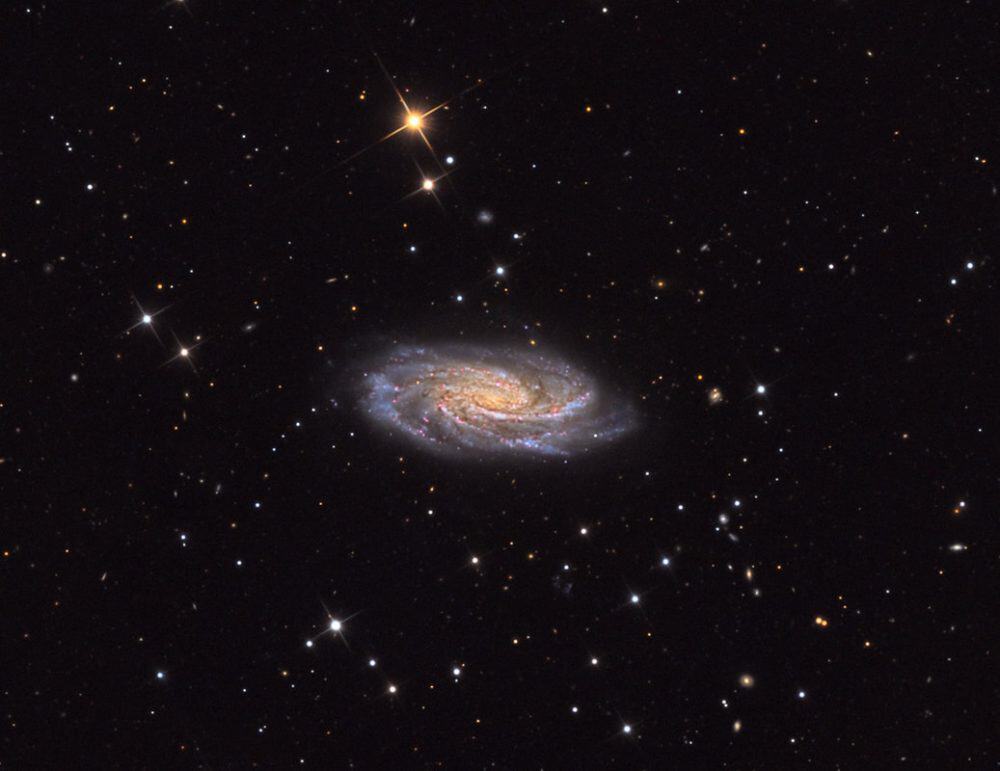Blog
This cosmic close-up looks deep inside the Soul Nebula. The dark and brooding dust clouds on the left, outlined by bright ridges of glowing gas, are cataloged as IC 1871. About 25 light-years across, the telescopic field of view spans only a small part of the much larger Heart and Soul nebulae. At an estimated distance of 6,500 light-years the star-forming complex lies within the Perseus spiral arm of our Milky Way Galaxy, seen in planet Earth’s skies toward the constellation Cassiopeia. An example of triggered star formation, the dense star-forming clouds of IC 1871 are themselves sculpted by the intense winds and radiation of the region’s massive young stars. The featured image appears mostly red due to the emission of a specific color of light emitted by excited hydrogen gas.
more...Randall Stuart Newman (born November 28, 1943 LA,CA) is an American singer-songwriter, arranger, composer, and pianist who is known for his distinctive voice, mordant (and often satirical) pop songs, and for film scores.
Since the 1980s, Newman has worked mostly as a film composer. His film scores include Ragtime, Awakenings, The Natural, Leatherheads, Cats Don’t Dance, Meet the Parents, Cold Turkey, and Seabiscuit. He has scored eight Disney–Pixar animated films: Toy Story, A Bug’s Life, Toy Story 2, Monsters, Inc., Cars, Toy Story 3, Monsters University, and Cars 3, as well as Disney’s The Princess and the Frog and James and the Giant Peach.
Newman has received twenty Academy Award nominations in the Best Original Score and Best Original Song categories and has won twice in the latter category. He has also won three Emmys, seven Grammy Awards, and the Governor’s Award from the Recording Academy.
Newman was inducted into the Songwriters Hall of Fame in 2002 for classics such as “Short People“, and as a Disney Legend in 2007. Newman was inducted to the Rock and Roll Hall of Fame in April 2013.
more...Leandro “Gato” Barbieri (28 November 1932 – 2 April 2016) was an Argentine jazz tenor saxophonist who rose to fame during the free jazz movement in the 1960s and is known for his Latin jazz recordings of the 1970s. His nickname, Gato, is Spanish for “cat”.
Born to a family of musicians, Barbieri began playing music after hearing Charlie Parker‘s “Now’s the Time”. He played the clarinet and later the alto saxophone while performing with the Argentinean pianist Lalo Schifrin in the late 1950s. By the early 1960s, while playing in Rome, he also worked with the trumpeter Don Cherry. By now influenced by John Coltrane‘s late recordings, as well as those from other free jazz saxophonists such as Albert Ayler and Pharoah Sanders, he began to develop the warm and gritty tone with which he is associated. In the late 1960s, he was fusing music from South America into his playing and contributed to multi-artist projects like Charlie Haden‘s Liberation Music Orchestra and Carla Bley‘s Escalator Over The Hill. His score for Bernardo Bertolucci‘s 1972 film Last Tango in Paris earned him a Grammy Award and led to a record deal with Impulse! Records
more...Roy McCurdy (born November 28, 1936) is a jazz drummer.
Before joining Cannonball Adderley‘s Quintet in 1965 and staying with the band until Adderley’s death in 1975, he had played with Chuck and Gap Mangione in the Jazz Brothers (1960–1961), as well as with Bobby Timmons, Betty Carter and Sonny Rollins (1963–1964), appearing on the classic 1963 album Sonny Meets Hawk!
He attended the Eastman School of Music from sixteen to eighteen, during which time he also played professionally with Roy Eldridge and with Eddie Vinson at seventeen. In 1960 he joined the Art Farmer – Benny Golson Jazztet and remained for two years.
Among the influences he cites Louie Bellson, Shelly Manne, Sam Woodyard, Buddy Rich, Papa Jo Jones, Philly Joe Jones and the bands of Duke Ellington, Jimmie Lunceford and Lionel Hampton.
He has also played and/or recorded with Count Basie, Wes Montgomery, Ella Fitzgerald, Sarah Vaughan, Carmen McRae, Joe Williams, Herbie Hancock, Oscar Peterson, Bud Powell, Art Pepper, and the jazz rock group Blood, Sweat and Tears, etc.
more...Gigi Gryce (born George General Grice Jr.; November 28, 1925 – March 14, 1983) was an American jazz saxophonist, flautist, clarinetist, composer, arranger, and educator.
While his performing career was relatively short, much of his work as a player, composer, and arranger was quite influential and well-recognized during his time. However, Gryce abruptly ended his jazz career in the 1960s. This, in addition to his nature as a very private person, has resulted in very little knowledge of Gryce today. Several of his compositions have been covered extensively (“Minority“, “Social Call”, “Nica’s Tempo”) and have become minor jazz standards. Gryce’s compositional bent includes harmonic choices similar to those of contemporaries Benny Golson, Tadd Dameron and Horace Silver. Gryce’s playing, arranging, and composing are most associated with the classic hard bop era (roughly 1953–1965). He was a well-educated composer and musician, and wrote some classical works as a student at the Boston Conservatory. As a jazz musician and composer he was very much influenced by the work of Charlie Parker and Thelonious Monk.
George General Grice Jr. was born in Pensacola, Florida on November 28, 1925
more...Portugal
more...This image shows Sharpless 239 (Sh2-239 or LBN 821, left), a reflection nebula surrounded by LDN 1551, a dark star forming cloud of gas and dust. The region stretches for nearly 3 light-years near the southern end of the Taurus molecular cloud, a region where active star formation is taking place, some 453 light-years away in the constellation of Taurus, near the border of the constellation Perseus.
LDN 1551 contains a total amount of material equivalent to about 50 times the mass of the Sun, and inside it you will find a dozen of pre-main sequence stars. Star formation activity has caused the mix of dust and colors in the nebulae.
Lots of embedded young stellar objects are spewing material in the surrounding interstellar medium, including (near the center of the image) a compact, red jet of shocked hydrogen gas near the position of the infrared source L1551 IRS 5, known to be a binary system of protostars surrounded by dust disks, separated by about 40 AU. Just below it are the broader, brighter wings of HH 102, one of the region’s many Herbig-Haro objects.
Herbig–Haro objects (HH) – after astronomers George Herbig and Guillermo Haro – are narrow jets of gas and matter ejected by young stars at speeds of 100 to 1000 kilometers per second that collide with the surrounding nebula, producing bright shock fronts that glow as the gas is heated by friction while the surrounding gas is excited by the high-energy radiation of nearby hot stars. They are ubiquitous in star-forming regions, and several are often seen around a single star. The stellar jets seem to form as the swirling cloud of dust and gas surrounding a new star escapes.
These objects are transient phenomena, lasting not more than a few thousand years. They can evolve visibly over quite short timescales as they move rapidly away from their parent star into the gas clouds in interstellar space.
The star formation in this area seems to proceed quickly as told by the rapid evaporation in the foreground. Soon even the deepest parts of this cloud will be blown away, and young clusters of stars will shine with exuberance.
more...James Marshall Hendrix (born Johnny Allen Hendrix; November 27, 1942 – September 18, 1970) was an American rock guitarist, singer, and songwriter. Although his mainstream career spanned only four years, he is widely regarded as one of the most influential electric guitarists in the history of popular music, and one of the most celebrated musicians of the 20th century. The Rock and Roll Hall of Fame describes him as “arguably the greatest instrumentalist in the history of rock music”.
Born in Seattle, Washington, Hendrix began playing guitar at the age of 15. In 1961, he enlisted in the U.S. Army and trained as a paratrooper in the 101st Airborne Division; he was granted an honorable discharge the following year. Soon afterward, he moved to Clarksville, Tennessee, and began playing gigs on the Chitlin’ Circuit, earning a place in the Isley Brothers‘ backing band and later with Little Richard, with whom he continued to work through mid-1965. He then played with Curtis Knight and the Squires before moving to England in late 1966 after being discovered by Linda Keith, who in turn interested bassist Chas Chandler of the Animals in becoming his first manager. Within months, Hendrix had earned three UK top ten hits with the Jimi Hendrix Experience: “Hey Joe“, “Purple Haze“, and “The Wind Cries Mary“. He achieved fame in the U.S. after his performance at the Monterey Pop Festival in 1967, and in 1968 his third and final studio album, Electric Ladyland, reached number one in the U.S.; it was Hendrix’s most commercially successful release and his first and only number one album. The world’s highest-paid performer, he headlined the Woodstock Festival in 1969 and the Isle of Wight Festival in 1970, before his accidental death from barbiturate-related asphyxia on September 18, 1970, at the age of 27.
https://www.youtube.com/watch?v=W3JsuWz4xWc
more...Lyle David Mays (born November 27, 1953) is an American jazz pianist and composer best known as a member of the Pat Metheny Group.Metheny and Mays composed and arranged nearly all of the group’s music, for which Mays has won eleven Grammy Awards.
Bill Evans‘ album Live in Montreux and Miles Davis‘ album Filles de Kilimanjaro were important influences on his formation as a jazz musician. He graduated from the University of North Texas after attending the University of Wisconsin-Eau Claire. He composed and arranged for the One O’Clock Lab Band and was the composer and arranger of Grammy-nominated album Lab 75.
After leaving North Texas, Mays toured with Woody Herman‘s group for approximately eight months. In 1974, he met Pat Metheny with whom he later founded the Pat Metheny Group. Mays has won eleven Grammy Awards with the Pat Metheny Group and has been nominated for four others for his own work.
In an interview with JAZZIZ magazine in 2016, Mays revealed his current career as a software manager.
In the Pat Metheny Group, Mays provides arrangements, orchestration, and the harmonic and metric backbone of the group’s musical signature. He occasionally performs on electric guitar as well. He played trumpet on the songs “Forward March” and “Yolanda You Learn” from the album First Circle (1984) and during the tour for that album
more...Randal Edward Brecker (born November 27, 1945) is an American trumpeter, flugelhornist, and composer. His versatility in different musical genres has made him a sought-after player, equally accomplished in playing jazz, rock, and R&B. He has also worked as a studio player for many famous musicians. He has performed or recorded with Stanley Turrentine, Billy Cobham, Larry Coryell, Bruce Springsteen, Lou Reed, Sandip Burman, Charles Mingus, Blood, Sweat & Tears, Horace Silver, Frank Zappa, Parliament-Funkadelic, Chris Parker, Jaco Pastorius, Eliane Elias, Dire Straits, Todd Rundgren, Blue Öyster Cult, Richard Barone, Spyro Gyra, Barbara Dennerlein and many others. In his formative years, Brecker studied trumpet with Bill Adam at Indiana University.
Danongan Kalanduyan was a master of all aspects of the Mindanao tribal style of kulintang music and an essential artistic figure in practically all major Filipino-American communities for several decades.
more...https://www.youtube.com/watch?v=Yy0SJco8wDg
more...NGC 3672 is a spiral galaxy of the Hubble type SA (s) c in the constellation Becher south of the celestial equator , which is estimated to be 100 million light-years away from the Milky Way .
The object was discovered by astronomer William Herschel on March 4, 1786 using its 18.7-inchtelescope and later recorded by Johan Dreyer in the New General Catalog .
more...Tina Turner (born Anna Mae Bullock; November 26, 1939) is an American-born Swiss singer-songwriter, dancer, and actress. Turner rose to international prominence as a featured singer with Ike Turner‘s Kings of Rhythm before recording hit singles both with Ike and as a solo performer. One of the world’s best-selling artists of all time, she has been referred to as The Queen of Rock ‘n’ Rolland has sold more than 200 million records worldwide to date. She is noted for her energetic stage presence, powerful vocals, and career longevity. Turner held a Guinness World Record for the largest paid audience (180,000) for a solo performer.
Anna Mae Bullock was born to a small family in Nutbush, Tennessee. Growing up throughout the Southeastern United States, she began singing in local church choirs. She began her career in 1958 as a featured singer with Ike Turner‘s Kings of Rhythm, first recording under the name “Little Ann”. Her introduction to the public as Tina Turner began in 1960 as a member of the Ike & Tina Turner Revue. Success followed with a string of notable hits credited to the duo, including “A Fool in Love“,“It’s Gonna Work Out Fine“, “River Deep – Mountain High” (1966), “Proud Mary” (1971), and “Nutbush City Limits” (1973), a song that she wrote. In her autobiography, I, Tina (1986), she revealed several instances of severe domestic abuse against her by Ike Turner prior to their 1976 split and subsequent 1978 divorce. Raised a Baptist, she became an adherent of Nichiren Buddhism in 1973, crediting the spiritual chant of Nam Myoho Renge Kyo, which Tina says helped her to endure during difficult times.
https://www.youtube.com/watch?v=hzQnPz6TpGc
more...Jim Mullen (born 26 November 1945) is a Glasgow-born jazz guitarist with a distinctive style, like Wes Montgomery before him, picking with the thumb rather than a plectrum.
It was while both musicians were touring the United States with AWB in the mid-70s that Mullen met tenor saxophone player Dick Morrissey, and throughout the 1980s, he found critical notice as joint leader of the British jazz funk band Morrissey–Mullen. Record producer Richard Niles, who produced the band’s sixth album, It’s About Time, later produced three solo albums for Mullen.
Mullen has also played and recorded with, among others, Mose Allison, Hamish Stuart, Joanna Eden, Tam White, Claire Martin, Mike Carr, Jimmy Witherspoon, Dave O’Higgins and Georgie Fame, Sinan Alimanović, David Tughan and Frank Holder. Mullen has recorded as part of The AllStars, a collective of session musicians on their Paul McCartney-produced album All About the Music, alongside special guests Jocelyn Brown, Hamish Stuart and Angelo Starr.
more...Robert “Bobby” Sharp (born November 26, 1924 in Topeka, Kansas, † January 28, 2013 in Alameda, California ) was an American musician (piano, vocals) and songwriter, who among other things, the song Unchain My Heart wrote.
Sharp spent his childhood in Lawrence (Kansas) before moving to Los Angeles, where he lived with his grandparents during the Great Depression , while his parents, Louis and Eva Sharp, aspired to a concert tenor or athlete career in New York. In 1936, at the age of twelve, he lived with his parents in New York City. Her apartment on Edgecombe Avenue on Harlem’s Sugar Hill was a meeting place for prominent figures of the Harlem Renaissance; These included Walter White, the founder of the civil rights organization NAACP, Roy Wilkins, longtime NAACP chairman, and Aaron Douglas, an African-American artist also from Topeka. In the immediate vicinity lived Duke Ellington .
In 1943 Sharp served in the US Army in the 372nd Infantry Regiment , which was stationed in New York and Fort Breckenridge (Kentucky). After his release from the army, he studied music at the Greenwich House Music School and then at the Manhattan School of Music harmony, music theory and piano. An important mentor at this stage was bandleader Sy Oliver , a friend of the Sharp family. In the following years, Sharp tried to sell his own songs on Broadway and Tin Pan Alley; a first success was 1956 Baby Girl of Mine , which he recorded with orchestral accompaniment for the label Wing and was later covered by Ruth Brown . The song Last Night in the Moonlight he recorded under his own name for the small label Destiny. In 1960 he signed a record deal with Epic Records.
In the 1950s and 1960s his songs were u. a. Recorded by Sarah Vaughan , Sammy Davis, Jr. and most of all by Ray Charles . This played in 1961, the first version of Sharp’s most famous song Unchain My Heart , the cover versions of Trini Lopez and Joe Cocker (1987) followed. Bobby Sharp had sold the copyright of the song for only $ 50 to the musician and composer Teddy Powell , who then insisted on his co-authorship. Sharp sold his share to Powell in 1963 for only $ 1,000. In 1987, Sharp renewed the exploitation rights to the song, shortly before Joe Cocker successfully covered it.
more...https://www.youtube.com/watch?v=rn56jbqREAU
more...NGC 5548 is a Type I Seyfert galaxy with a bright, active nucleus. This activity is caused by matter flowing onto a 65 million solar mass (M☉) supermassive black hole at the core. Morphologically, this is an unbarred lenticular galaxy with tightly-wound spiral arms, while shell and tidal tail features suggest that it has undergone a cosmologically-recent merger or interaction event. NGC 5548 is approximately 245 million light years away and appears in the constellation Boötes. The apparent visual magnitude of NGC 5548 is approximately 13.3 in the V band.
In 1943, this galaxy was one of twelve nebulae listed by American astronomer Carl Keenan Seyfert that showed broad emission lines in their nuclei. Members of this class of objects became known as Seyfert galaxies, and they were noted to have a higher than normal surface brightness in their nuclei. Observation of NGC 5548 during the 1960s with radio telescopes showed an enhanced level of radio emission.Spectrograms of the nucleus made in 1966 showed that the energized region was confined to a volume a few parsecs across, where temperature were around 14000 K and the plasma had a dispersion velocity of ±450 km/s.
more...More Posts
- The Cosmos with Trapezium Cluster
- Stanley Clarke Day
- Andrew Hill Day
- World Music with Nico Kasanda
- Daily Roots with Hortense Ellis
- The Cosmos with M24
- Gilberto Gil Day
- Julian Priester Day
- World Music with Paco De Lucia
- Daily Roots with Alton Ellis & the Heptones
- The Cosmos with Sharpless 2-106
- John Medeski Day
- David Honeyboy Edwards Day
- World Music with Odpoczno
- Daily Roots with Ras Tweed
- The Cosmos with M8
- Johnny “Big Moose” Walker Day
- Elmo Hope Day
- Shad Collins Day
- World Music with Eleftheria Arvanitaki



